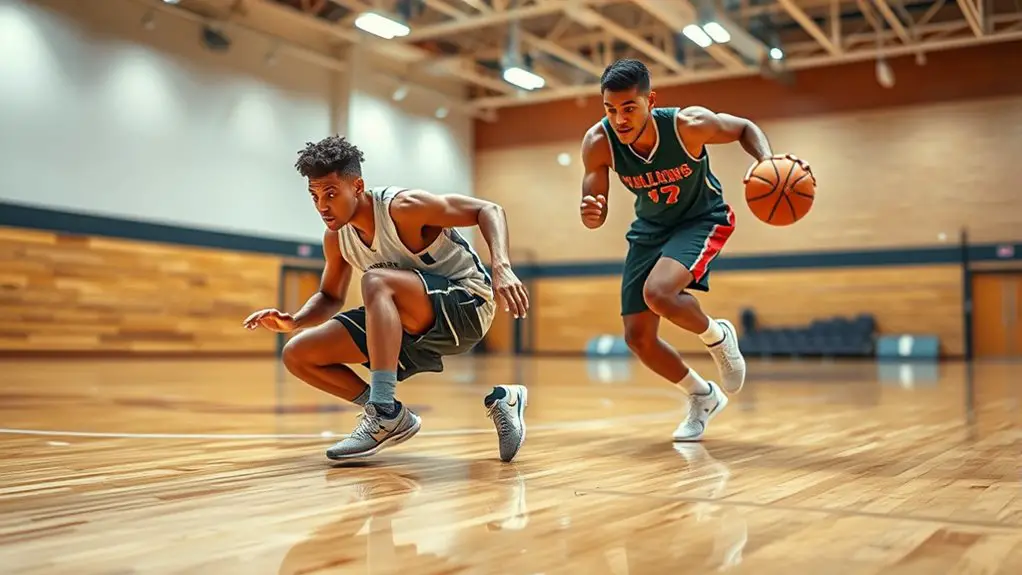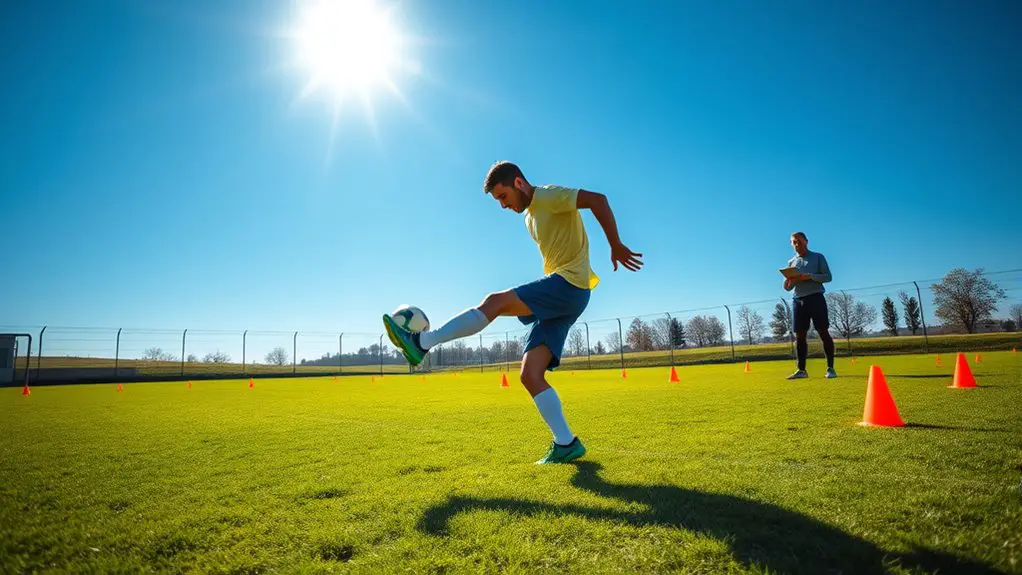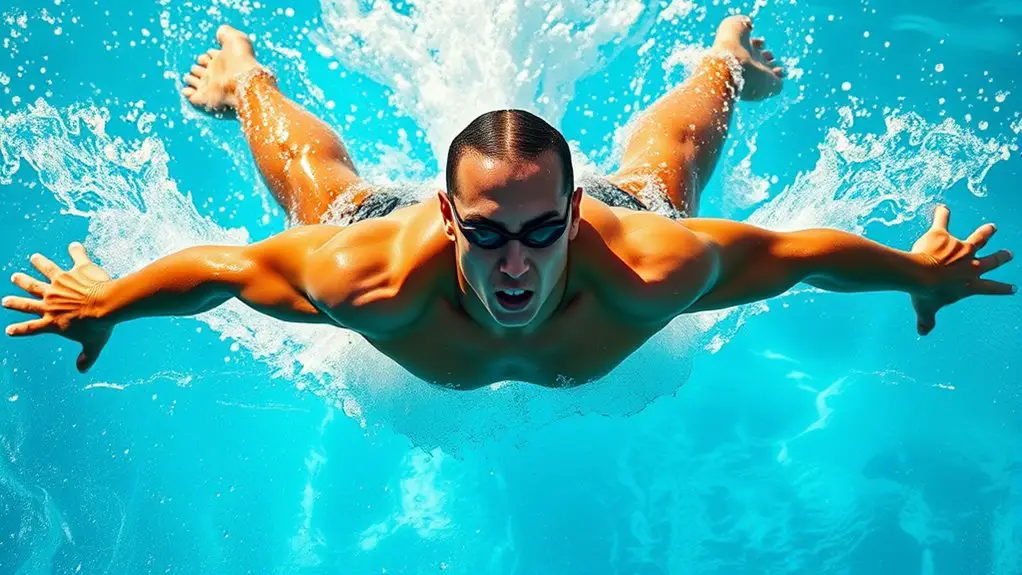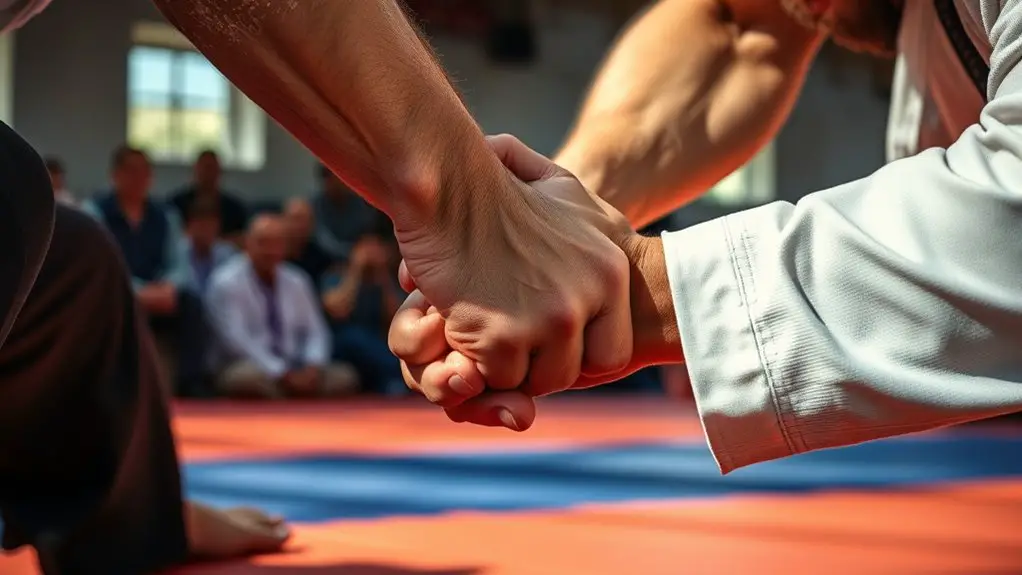To elevate your defensive game, focus on advanced footwork drills like the Zig-Zag Drill for agility and the Box Drill for balance and control. Incorporate lateral slides and the closeout technique to enhance reaction time. The defensive shuffle and cone drills can boost your quickness during direction changes. Practicing partner reaction drills will sharpen your anticipation skills on the court. Keep exploring to discover more effective techniques to transform your defensive prowess.
Importance of Footwork in Basketball Defense
When you think about effective basketball defense, footwork often stands out as an essential element. Mastering your footwork is vital for implementing solid basketball fundamentals and executing defensive strategies. Your ability to pivot, slide, and maintain balance can be the difference between stifling an opponent's drive or allowing an easy basket. Good footwork lets you react quickly, keeping you in front of the ball handler and minimizing their options. Additionally, proper footwork ensures that you reduce the risk of injuries while maintaining agility and stability on the court.
Basic Stance and Movement Principles
To be an effective defender, you need to start with a proper defensive stance. This foundational position not only sets you up for success but also enhances your lateral movement techniques on the court. Let's explore how mastering these basics can elevate your defensive game. Additionally, focusing on lateral movement techniques allows you to respond more effectively to your opponent's actions.
Proper Defensive Stance
A proper defensive stance is essential for effective basketball defense, as it sets the foundation for your movement and reaction to offensive players. Start by bending your knees and keeping your feet shoulder-width apart. This position allows you to stay balanced while maintaining a low center of gravity. Your weight should be on the balls of your feet, ready to spring into action. Embrace a defensive mindset, focusing on staying alert and anticipating your opponent's moves. Remember, footwork fundamentals are key—keep your hands active and eyes on the ball. By mastering this stance, you'll enhance your ability to defend effectively, giving you the freedom to react swiftly and confidently in any situation on the court.
Lateral Movement Techniques
While maintaining a proper defensive stance is essential, mastering lateral movement techniques is equally important for effective defense in basketball. You'll want to focus on developing lateral agility, which allows you to move quickly side to side, keeping up with your opponent. Start by getting low in your stance, feet shoulder-width apart, and your weight balanced on the balls of your feet. This position promotes lateral balance, enabling you to shift your weight efficiently. Practice shuffling to the side, keeping your knees bent and hands up, ready to react. Incorporate drills that involve quick direction changes to enhance your agility and balance. With consistent practice, you'll find yourself defending more effectively, allowing for greater freedom on the court.
Lateral Slides Drill
When it comes to mastering the Lateral Slides Drill, proper stance techniques are essential for effective movement. You'll need to focus on your timing and speed to stay in front of your opponent. Incorporating cone drills can further enhance your agility and footwork during this critical defensive skill. Additionally, consistent practice of agility ladder drills can significantly improve your overall foot speed and coordination.
Proper Stance Techniques
Mastering proper stance techniques is essential for effective lateral movement on the basketball court, and the Lateral Slides Drill is a perfect way to develop this skill. Start by positioning your feet shoulder-width apart, ensuring proper body alignment. Your knees should be slightly bent, allowing for quick shifts in direction. Focus on foot placement techniques—using the balls of your feet helps you stay light and agile. As you slide laterally, keep your hips low and your chest up; this'll enhance your balance and readiness. Practice shifting your weight smoothly from side to side, maintaining that stance. With consistent effort, you'll improve your lateral movement, making you a more effective defender on the court. Embrace the freedom this technique brings to your game!
Timing and Speed
One key aspect of the Lateral Slides Drill is timing and speed, which are essential for effectively guarding your opponent. As you practice, focus on your foot placement and the rhythm of your movements. Timing drills help you anticipate your opponent's actions, allowing you to react quickly and stay one step ahead. When executing lateral slides, aim for smooth, explosive movements that enhance your speed on the court. Consistent practice will lead to speed enhancement, making it harder for opponents to shake you off. Remember, it's not just about how fast you can move; it's also about when to make those moves. Mastering this balance will improve your defensive skills and give you the freedom to dominate on the court.
Incorporating Cone Drills
To effectively incorporate cone drills into your training regimen, start by setting up a series of cones in a straight line or zigzag pattern. Pay attention to your cone placement; spacing them about three feet apart allows for ideal movement. Once set, you can create drill variations by focusing on lateral slides. Move side to side, keeping your hips low and feet quick. As you slide, visualize an opponent trying to get past you, which adds intensity to your practice. Experiment with different cone arrangements to challenge your agility and reaction time. By consistently integrating these drills, you'll sharpen your defensive footwork, giving you the freedom to adapt on the court. Remember, it's all about fluidity and control!
Closeout Technique Drill
As you develop your defensive skills, focusing on the closeout technique can greatly impact your effectiveness on the court. Mastering closeout positioning is essential; you want to approach the shooter with your body balanced and in a low stance. This allows you to react quickly if they drive past you. Start by sprinting toward the shooter, emphasizing closeout speed while keeping your hands up to contest the shot.
To practice, set up a partner or coach as the shooter and time your approach. Aim for a controlled yet aggressive closeout, ensuring you don't overcommit and leave yourself vulnerable. Remember to maintain eye contact with the shooter and stay aware of your surroundings—this freedom of movement will help you adjust to any offensive play. With consistent practice, your closeout technique will become second nature, making you a formidable defender on the court. Additionally, incorporating agility drills into your training can enhance your overall defensive performance.
Zig-Zag Drill for Agility
The Zig-Zag drill is a fantastic way to boost your agility on the court. By mastering key techniques, you'll not only enhance your footwork but also improve your defensive skills. Let's explore the benefits of this drill and the essential moves you need to focus on. Incorporating functional strength training into your regimen can significantly enhance your overall agility and performance on the basketball court.
Benefits of Zig-Zag Drills
Zig-zag drills are an essential part of any basketball defender's training regimen, offering numerous benefits that enhance agility and footwork. By incorporating zig-zag variations into your practice, you'll see significant improvements. Here are three key zig-zag benefits:
- Improved Agility: The quick changes in direction help you move faster and more efficiently on the court.
- Enhanced Coordination: These drills promote better body control, allowing you to stay balanced while defending.
- Increased Reaction Time: Zig-zag drills sharpen your ability to react quickly to offensive movements, making you a more versatile defender.
Embrace these benefits and elevate your defensive game, giving you the freedom to move fluidly and effectively during every play.
Key Techniques to Master
To truly excel in zig-zag drills, mastering key techniques is essential for enhancing your agility on the court. Start by focusing on your footwork fundamentals—keep your stance low, and use quick, small steps to change direction seamlessly. As you move, engage your core for balance and stability, allowing for rapid shifts in position. Incorporate head fakes and body shifts to mimic real-game situations, making your defensive strategies more effective. Remember to stay light on your feet; this helps in reacting quickly to offensive movements. Finally, practice consistently to build muscle memory, ensuring these skills become second nature. With dedication, you'll find your agility improves, making you a more formidable defender on the court.
Mirror Drill for Reaction Time
When you're honing your defensive skills, the Mirror Drill is an essential exercise that sharpens your reaction time. This drill helps you develop quicker instincts and better footwork, allowing you to stay one step ahead of your opponent. By utilizing mirror feedback from a partner or coach, you can see your movements in real-time, leading to significant reaction improvement.
The Mirror Drill sharpens your reaction time and footwork, helping you stay one step ahead of your opponent.
To perform the Mirror Drill effectively, follow these steps:
- Positioning: Stand facing your partner, maintaining a distance of about five feet.
- Movement: As your partner moves side to side, mimic their movements as closely as possible.
- Response: When your partner changes direction, react immediately with corresponding footwork to maintain your defensive stance.
This drill not only enhances your agility but also fine-tunes your ability to read the game, making you a more formidable defender on the court. Additionally, practicing this drill can help improve your mental clarity and decision-making skills under pressure.
Box Drill for Balance and Control
The Box Drill is a powerful exercise designed to enhance your balance and control on the court. By creating a visual square, you'll practice moving quickly in all directions, which is essential for effective defense. Start by marking a box with cones or tape, ideally about 10 feet by 10 feet. As you move from cone to cone, incorporate various balance exercises like single-leg stands and lateral hops. This'll challenge your body's stability while reinforcing your control techniques.
Focus on maintaining a low center of gravity, which helps you stay agile and responsive. Remember to engage your core, as it plays an important role in your overall balance. As you become more comfortable, increase the speed of your movements to simulate game situations. The Box Drill not only improves your footwork but also boosts your confidence, allowing you to navigate the court freely and effectively when it matters most. Additionally, a strong core reduces injury risk, supporting your movements and enhancing your performance on the court.
Defensive Shuffle Drill
While mastering footwork is essential for any basketball defender, the Defensive Shuffle Drill specifically targets lateral movement and quick shifts. This drill helps you stay low, maintain balance, and react swiftly to your opponent's movements.
To maximize your effectiveness, focus on these key aspects:
- Proper Stance: Keep your feet shoulder-width apart and knees bent to lower your center of gravity.
- Quick Feet: Move side to side, using short, choppy steps rather than long strides to enhance speed and agility.
- Defensive Communication: Constantly call out cues to your teammates, reinforcing defensive strategies and maintaining awareness.
Incorporating these footwork strategies into your routine will not only improve your lateral movement but also elevate your overall defensive game. Additionally, enhancing your core strength will further support your ability to maintain balance and agility on the court. Embrace the freedom of movement and watch as your skills transform on the court!
Cone Drill for Quick Direction Changes
To enhance your ability to change directions quickly on the court, incorporating the Cone Drill into your training is essential. This drill focuses on cone placement to improve your agility and responsiveness. Start by setting up a series of cones in a zigzag pattern, spaced about 5-7 feet apart. As you sprint towards the first cone, practice planting your outside foot and pushing off in the opposite direction. This mimics the rapid shifts in movement you'll face during games.
Keep your knees bent and your body low to maximize your balance and control. As you get comfortable, increase your speed and try to minimize the time spent at each cone. This drill isn't just about speed; it's also about learning to read your body's movements. With consistent practice, you'll notice significant agility improvement, making you a more effective defender on the court. Additionally, cross-training can enhance your cardiovascular endurance, allowing you to maintain high energy levels throughout the game.
Partner Reaction Drill for Anticipation Skills
Building on the agility developed through the Cone Drill, the Partner Reaction Drill sharpens your anticipation skills, which are essential for effective defense. This drill emphasizes partner communication and helps you read your opponent's movements better. Here's how to execute it:
The Partner Reaction Drill enhances anticipation skills, fostering better communication and defensive awareness between partners.
- Setup: One partner dribbles while the other defends. The dribbler changes direction randomly.
- Read and React: As the dribbler moves, focus on your partner's body language and footwork to anticipate their next move.
- Feedback Loop: After each round, discuss what worked and what didn't, refining your anticipation techniques together.
Frequently Asked Questions
How Often Should I Practice Footwork Drills for Maximum Improvement?
You might think practicing footwork drills every day is too much, but consistency is key for real improvement. Aim for at least three to four times a week. This practice frequency allows you to refine your skills without burning out. Over time, you'll notice significant progress in your agility and balance. With dedication, you'll see improvements within a few weeks. So, embrace that freedom to train and watch your game evolve!
Can These Drills Be Adapted for Youth Basketball Players?
Absolutely, you can adapt these drills for youth basketball players! By simplifying movements and focusing on foundational skills, you'll guarantee they develop confidence and technique. Youth adaptations should emphasize fun while teaching essential footwork. Incorporate game-like scenarios to keep them engaged and motivated. Remember, the goal is skill development at their own pace; let them enjoy the process without pressure, and you'll see them grow as players while having a blast!
What Shoes Are Best for Performing Footwork Drills?
Did you know that 70% of injuries in basketball are related to footwear? When choosing shoes for footwork drills, focus on features like traction, cushioning, and ankle support. Brands like Nike and Adidas offer excellent options designed for agility and comfort. You'll want something that lets you move freely without compromising stability. Investing in the right shoes can boost your performance and keep you safe while you sharpen your skills on the court.
How Do I Track My Progress in Footwork Skills?
To track your progress in footwork skills, use self-assessment techniques like video analysis. Record yourself during drills, then review the footage to spot areas for improvement. You can also keep a journal to note your goals and achievements. Setting specific milestones can help you measure your growth over time. Remember, it's all about enjoying the journey and feeling free to adapt your techniques as you evolve. Celebrate every small win along the way!
Are There Any Common Mistakes to Avoid During Footwork Drills?
When practicing footwork, it's easy to overlook some common mistakes. One major issue is improper foot placement; if your feet aren't positioned correctly, it can throw off your balance and effectiveness. Also, don't forget about drill intensity; pushing too hard can lead to poor technique. Remember, it's not just about speed but precision. Focus on mastering each movement, and you'll find greater freedom and control in your overall performance.




